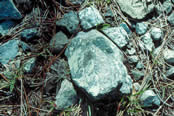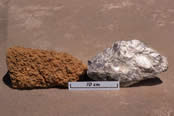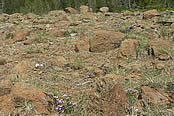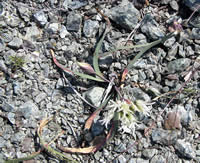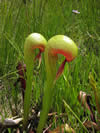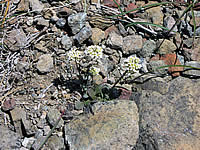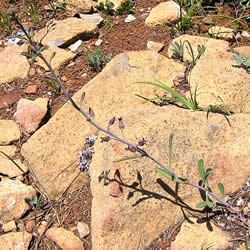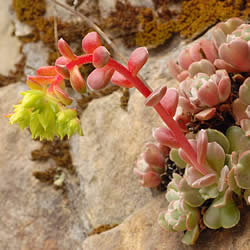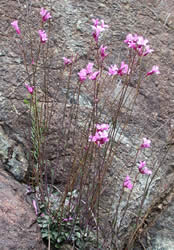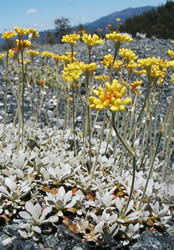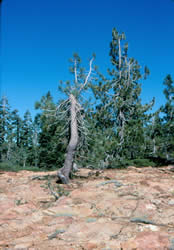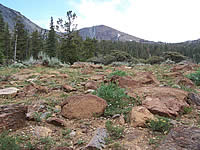USDA Forest Service Celebrating Wildflowers
|
|
|
Serpentine Soils and Plant AdaptationsThe embedded ultramafic rocks of the ophiolite complex find their way to the surface either by erosion of material above the ophiolite or uplift in the course of tectonic activity. Depending on the mineralogy and forces operating in the physical or chemical environment (metamorphosis), the broad classification of ultramafic rock can be divided into two rock types: serpentinite and peridotite. Serpentinite is the result of intense deformation caused by the force of crustal movement. The rock develops fractures into which water will flow. This hydration process changes the mineralogy of the rock resulting in the creation of serpentine, a polished, gray-green-black rock. For peridotite, the minerals present in the mantle are retained yielding a warty, red to orange rock. The term "serpentine" is commonly used to include both serpentinite and peridotite. Once exposed to the elements, serpentine rock weathers to form soil. The resultant soils are a byproduct of the mineralogy of the rock, from which it is formed, but other factors come into play like rainfall, topography, and the length of time the serpentine rock has been exposed. All of these factors result in a tremendous variety of soil types derived from serpentine, yet there are characteristics of serpentine soils in common that have bearing on the plants that occupy these areas and their distinctive plant community. What Plants Need and What They Will TolerateAll plants need water at some level and a substrate, like soil, to hold them in place. Plant survival and growth depends on what is in the soil, or the soil’s fertility. Essential nutrients in the soil include nitrogen, phosphorus, and potassium along with calcium, magnesium, and various trace metals such as nickel and iron. These nutrients play a role in development of plant tissue. Not only is the presence of these nutrients important, but respective concentrations are also vital. Serpentine soils are unique in that they vary notably from the model of soil fertility. To the contrary, serpentine soils house only those plant species that can tolerate extreme conditions, in particular:
While calcium is poorly represented in serpentine soils, its availability to plants is further complicated by high concentrations of magnesium that inhibit calcium uptake. The following table provides comparisons of magnesium (Mg) and calcium (Ca) concentrations across various rock types to illustrate the distinctiveness of ultramafic rock.
From Alexander, E.B. et al. 2007. Serpentine Geoecology of Western North America. Table 8.3 Nutrient Element Concentration in Rocks. Which was from Turkekian, K. K. and K. H. Wedepohl. 1961. Distribution of the Elements in some major units of the earth’s crust. Geological Society of America Bulletin 72: 175-192. Botanical CarnivoryPlants have other ways of obtaining nitrogen in a nitrogen-limited environment, such as eating insects. The California pitcher plant, Darlingtonia californica, is a rare carnivorous plant of serpentine wetland communities. California pitcher plant obtains its nitrogen by decomposing insects captured in the pitcher-shaped leaves. The insects crawl down inside the picture where they are trapped by a barrier of downward facing hairs. Bacteria and invertebrates then decompose the trapped insects. Heavy metals are naturally present as micronutrients, but at high concentrations can alter cell membranes and reduce root growth. The interactions between calcium, magnesium, and such heavy metals as nickel are complex at best, whereby magnesium may block the uptake of calcium, while calcium may reduce effects of excess magnesium, and both magnesium and calcium may reduce toxic effects of the heavy metal nickel. Nitrogen is primarily derived from decomposed organic material. Organic material in serpentine environments occurs sparingly. The atmosphere is another source of nitrogen but must first be converted to a form usable to plants. Bacteria that form nodules on the roots of certain plants accomplish the conversion of atmospheric nitrogen. Plant species in the genus Ceanothus are known to fix nitrogen (nitrogen fixation) and are common members of the serpentine flora. Scientists agree that there are no typical serpentine soils and no typical responses by plants to these interactions. Plants that prevail on serpentine soils are those that have developed adaptive strategies to tolerate what most plant will not! Getting Along in a Challenging World: Adaptations and TolerancesWhile there are challenges to the infertility of serpentine soils, all is far from grim living on the edge. Instead of characterizing these environments as “harsh” or the soils as “toxic”, perhaps plants on serpentine don’t need so much calcium, maybe high levels of magnesium is the new essential nutrient, perhaps nickel is distasteful to grazing insects, and it could just be that serpentine plants are actually thriving in their environment. Tolerances and adaptations range from those at the cellular level to those apparent to the naked eye. High concentrations of nickel are tolerated in some serpentine plants by exclusion, reduced transfer of nickel from root to shoot, or hyperaccumulation. Other plants adapt to a low calcium environment, by selectively up taking this nutrient rather than magnesium. Morphological adaptations to dry and high light environments (and possible nutrient deficiencies) include fleshy leaves, leaf hairs, and protective pigments. The basal rosette growth form, a common form of serpentine perennials, reduces the incident of desiccation by locating its leaves close to the ground surface out of the drying influence of the wind.
Plant growth on serpentines is typically stunted. Woody plants that grow to tree height on non-serpentine soils grow in a dwarfed or shrub-like form on serpentine soils.
Biotic variables, beyond the morphological or physiological, contribute to the ability some plants possess to find nutrients in a nutrient-limited environment. Mycorrhizal relationships - the relationship between a plant and a fungus under ground - facilitate the scavenging and uptake of nutrients by extending the absorptive surface of the fine roots through development of threads called hyphae. These fungi also produce enzymes that decompose organic matter, a source of nitrogen. Is it Nurture or Nature?
Some plant species are seldom if ever found on serpentines, others are indifferent meaning they can occur both on, or off, serpentines, yet others are almost entirely restricted to serpentines. These distinctions are undoubtedly the result of evolutionary processes, but what mechanism drives the process? Are plants somehow genetically pre-adapted to life on the edge? Did the selective pressures of life on serpentines further separate these plants from others over time? Is it nurture or nature? Likely both, but for now, it is sufficient to say that growth and survival of species on serpentine is a function of the "serpentine syndrome", the sum of the response to physical, biological, chemical and temporal factors. Bookmarksserpentinite and peridotite - Ultramafic rock consists of magnesium-iron silicate minerals, such as olivine and pyroxene and forms the upper mantle of the earth. The crust (oceanic and continental) is situated above the mantle. The part of the mantle forming the “basement” of the oceanic crust is termed peridotite. Peridotite consists primarily of olivine. In mountain building areas, peridotite exposed to pressure can subsequently fracture. Water entering the fracture alters the mineralogy of the peridotite to form serpentinite. In serpentinite rock, the olivine and pyroxene alter to form serpentine minerals, such as magnesium silicate, talc, and magnetite. Serpentinite can come in many colors depending on the specifics of the mineralogy. nitrogen fixation - Plants need nitrogen in relatively large quantities. In serpentine areas, nitrogen via decomposition of organic material is likely limited due to the general paucity of organic biomass in serpentine area. Atmospheric nitrogen is the more likely contributor in serpentine environments but it must first be converted to a different form before plant uptake. In the serpentine world, this conversion or fixation is primarily the work of bacteria living in nodules on the plants’ roots. Bacteria obtain carbon from the plants and in return provide fixed nitrogen, specifically, ammonia. The greatest potential for nitrogen fixation in serpentine soils is in the root zone of certain legumes (e.g. Lotus or Lupinus spp.) or woody species such as Ceanothus spp. hyperaccumulation - is the adaptation by plants to high heavy metals such as nickel found in serpentine soils. Nickel taken up in the roots becomes concentrated in leaf tissue. In micrograms/gram Thlaspi montanum, a species in the mustard or Brassicaceae family, concentrates 3833 micrograms in its foliage. Species in the genus Streptanthus spp., also in the Brassicaceae family, ranks second with 2400 to 2800 micrograms. These concentrations are in sharp contrast to other serpentine associated plants sampled in the various studies which contain less than 434 micrograms. (Data from: Alexander, E.B. et al. 2007- Table 8.5, which summarized various studies of trace element concentrations in foliage of California and southwest Oregon plants from serpentine soils.) serpentine syndrome - a phrase coined by Hans Jenny (1980) to explain plant survival on serpentine as a summed response to several factors: chemical, biological, physical, and temporal. Resources and References
|
||||||||||||||||||||||||||||||
| NOTE: PDF format links require the Adobe Acrobat Reader to view. | ||||||||||||||||||||||||||||||
| top | Disclaimers | FOIA | Privacy Policy | Quality of Information | Photo Credits & Use | |||||||||||||||||||||||||||||
Location: http://www.fs.fed.us/wildflowers/communities/serpentines/adaptations.shtml
Last modified: Wednesday, 03-Dec-2008 13:55:12 EST
